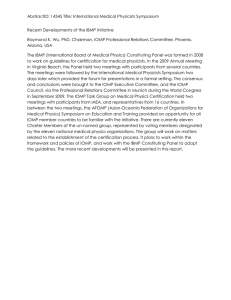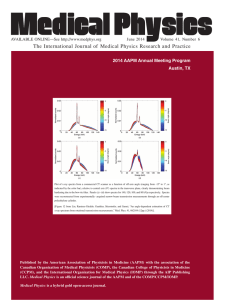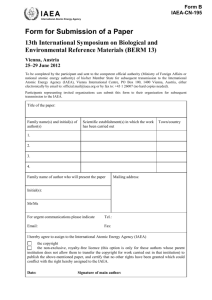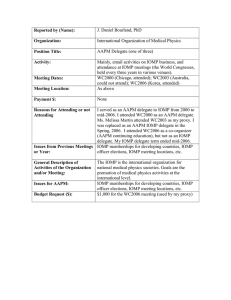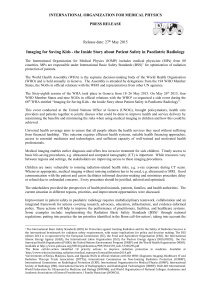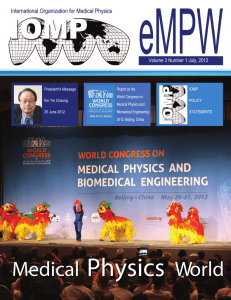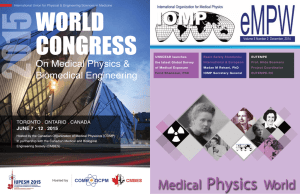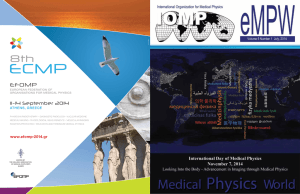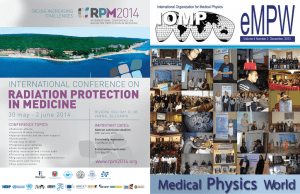IOMP Role On the International Stage Scope 8/2/2012
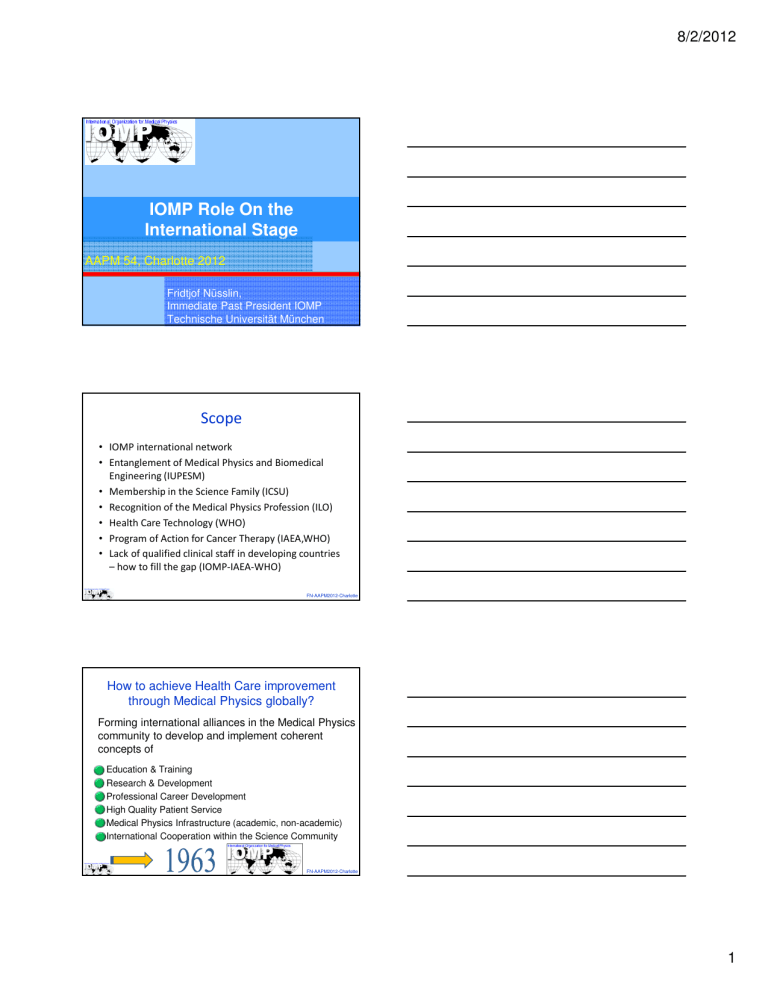
8/2/2012
IOMP Role On the
International Stage
AAPM 54, Charlotte 2012
Fridtjof Nüsslin,
Immediate Past President IOMP
Technische Universität München
Scope
• IOMP international network
• Entanglement of Medical Physics and Biomedical
Engineering (IUPESM)
• Membership in the Science Family (ICSU)
• Recognition of the Medical Physics Profession (ILO)
• Health Care Technology (WHO)
• Program of Action for Cancer Therapy (IAEA,WHO)
• Lack of qualified clinical staff in developing countries
– how to fill the gap (IOMP-IAEA-WHO)
FN-AAPM2012-Charlotte
How to achieve Health Care improvement through Medical Physics globally?
Forming international alliances in the Medical Physics community to develop and implement coherent concepts of
• Education & Training
• Research & Development
• Professional Career Development
• High Quality Patient Service
• Medical Physics Infrastructure (academic, non-academic)
• International Cooperation within the Science Community
FN-AAPM2012-Charlotte
1
International Organization for
Medical Physics (IOMP) [1963]
• represents ca. 18.000 medical physicists worldwide
•
80 affiliated national member organizations.
•
6 Regional Organisations as Members
• plus Corporate Members
MISSION
• To disseminate scientific and technical information
• To foster the educational and professional development
• To promote the highest quality medical services for patients
02.08.2012
4
FN-AAPM2012-Charlotte
The IUPESM represents the combined efforts of more than 40,000 medical physicists and biomedical engineers working on the physical and engineering science of medicine.
“The principal objective of IUPESM is to contribute to the advancement of physical and engineering sciences in medicine for the benefit and well being of humanity.”
FN-AAPM2012-Charlotte
IOMP – International Cooperations
ICSU
IUPAP
IUPAB
IAEA
WHO
IRPA
ICRP
ICRU
ISR
ILO
BIPM
FN-AAPM2012-Charlotte
8/2/2012
2
International Council for Science (ICSU)
ICSU to launch global initiative for monitoring urban health
Currently, more than half the world's people live in cities,
The major threats to public health — such as heart disease, diabetes and cancers — arise from a combination of behavioural, economic and social factors, all of which interact with biological risk factor
FN-AAPM2012-Charlotte
Objective : Recognition of the Medical Physics profession by the National Health Authorities
Achievement:
First time:
Classification of ‘Medical Physicist’ by ILO
FN-AAPM2012-Charlotte
I
nternational Standard Classification of
Occupations, 2008 (ISCO-08)
2111 Physicists and astronomers
Physicists and astronomers conduct research, improve or develop concepts, theories and operational methods concerning matter, space, time, energy, forces and fields and the interrelationship between these physical phenomena.
They apply scientific knowledge relating to physics and astronomy in industrial,
medical
, military or other fields.
FN-AAPM2012-Charlotte
8/2/2012
3
I
nternational Standard Classification of
Occupations, 2008 (ISCO-08)
Tasks include –
(e) ensuring the safe and effective delivery of radiation (ionising and non-ionising) to patients to achieve a diagnostic or therapeutic result as prescribed by a medical practitioner;
(f) ensuring the accurate measurement and characterization of physical quantities used in medical applications ;
(g) testing, commissioning and evaluating equipment used in applications such as imaging, medical treatment and dosimetry ;
(h ) advising and consulting with medical practitioners and other health care professionals in optimizing the balance between the beneficial and deleterious effects of radiation
FN-AAPM2012-Charlotte
I
nternational Standard Classification of
Occupations, 2008 (ISCO-08)
Examples of the occupations classified here:
- …….
Medical Physicist …..
Notes
It should be noted that, while they are appropriately classified in this unit group with other physicists, medical physcists are considered to be an integral part of the health work force alongside those occupations classified in sub-major group 22, Health professionals …….
FN-AAPM2012-Charlotte
World Health Organization (WHO)
Radiation in Health Care
The use of radiation in health care is by far the largest contributor to the exposure of the general population from artificial sources
Annually worldwide
3,600 million X-ray exams
(> 300 million in children)
37 million nuclear medicine procedures
7.5 million radiation oncology treatments
[UNSCEAR Report 2008]
FN-AAPM2012-Charlotte
8/2/2012
4
World Health Organization (WHO)
International Basic Safety Standards (BSS)
The ( BSS ) mark the culmination of efforts towards global harmonization of radiation safety requirements.
However, the involvement of the health sector in the BSS implementation is still weak and scant.
There is a need to mobilize the health sector towards safer and effective use of radiation in medicine.
FN-AAPM2012-Charlotte
WHO - IAEA PACT programme
PACT
=
P rogramme of
A ction for
C ancer
T reatment
• National Cancer Control Programme
•
Education
• Prevention
• Screening
• Diagnosis –
Radiology, Nuclear medicine
, Pathology
• Treatment – Surgery,
Radiotherapy
, Chemotherapy
• Palliative Care
• Cancer Registry
PACT Model Demonstration Sites
Albania, Tanzania, Nicaragua, Vietnam, Sri Lanka, Yemen
G.Morgan, PACT Programme Office, IAEA
FN-AAPM2012-Charlotte
WHO - IAEA PACT programme
AGaRT = A dvisory G roup on increasing A ccess to R adiotherapy
Objective
• Increasing access to radiotherapy in low and middle income countries
• Complete, integrated solutions for radiotherapy which are affordable, safe, reliable, effective and suitable for lowresource settings
Composition
• Users from developing countries
• International Organisations: IAEA, WHO, IEC, World Bank
• Scientific and professional societies ( IOMP , ….)
• Manufacturers of diagnostic and radiotherapy equipment
G.Morgan, PACT Programme Office, IAEA FN-AAPM2012-Charlotte
8/2/2012
5
Challenges in providing radiotherapy in
Developing Countries
Limitations in delivery, operation & maintenance of RT equipment
• Limited warranty & service contracts
• Instabilities in manufacturers’ local representatives
• Lack of trained maintenance engineers & physics staff at RT centres
Human Resources
• Lack of qualified staff and radiotherapy experience
• Lack of training opportunities, learning centres and Centres of
Excellence
• Lack of training for new equipment / training of the wrong staff / no continuous training / brain drain
G.Morgan, PACT Programme Office, IAEA
FN-AAPM2012-Charlotte
Qualification of Medical Physicist
(IOMP Policy Document 2)
Bachelor
Physics /
Engineering
3 Years
4 - 5 Years
University Study
Master
/Diploma
Physics /
Engineering
Thesis
Medical
Physics
1-2
Years
Residency
Competency
Training
(Formal
Residency /
Clinical
Training
Program
2 Years
Hospital
Continuous
Professional
Development
The Emergency Situation in
Developing Countries
FN-AAPM2012-Charlotte
8/2/2012
6
Hospital University
Company
WHO IAEA IOMP
Travel Grants
Course Materials
Selection of Experts
Accreditation
Location : Customer´s
Hospital (Reference site of the company)
Academia : Link to a local
University
Faculty : Preferably local & few foreign Trainers (QMP)
Sustainability: repeated courses with the same faculty & audience
Training:
•
•
Part 1 :Fundamental MP &
Practicing (IOMP)
Part 2 : First maintenance
(Company Staff)
Conclusion
Networking with International Organizations are a prerequisite to meet the fundamental aims of the IOMP as layed down in the Mission
Statement,i.e.
• To disseminate scientific and technical information
• To foster the educational and professional development
• To promote the highest quality medical services for patients
Networking with International Organizations is of particular importance
• To provide adequate, efficient and safe utilization of health care technologies
• To promote medical physics in developing countries
• To make the cancer treatment programme of the WHO & IAEA a success
FN-AAPM2012-Charlotte
8/2/2012
7
